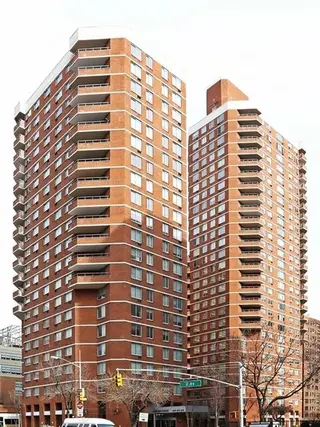 Carter Horsley
Carter HorsleyMay 12, 2015
Carter's Review
This large complex was one of several very large residential projects that dramatically transformed the East Midtown South neighborhood north of 23rd Street near the East River in the late 1960s and early 1970s.
Originally known as Henry Phipps Plaza West, it was designed by Frost Associates and completed in 1976 on a “superblock” site on the east side of Second Avenue between 26th and 29th Street. The 8-building group, which ranged in height from 12 to 27 stories, was completed as a Mitchell-Lama co-operative with 1,600 units.
It was built two years after East Midtown Plaza was completed just to the south on a large site between Second and First Avenues and from 23rd to 24th Streets with a small addition midblock segment that stretched to 25th Street. Both projects were faced with red-brick, as were the area’s earlier and larger Stuyvesant Town and Peter Cooper Village, and white concrete but East Midtown Plaza was significantly more important architectural with a strong sculptural mid-rise section framed by end towers that were angled and had more balconies with solid parapet walls.
East Midtown Plaza was designed by David Brody & Associates who would two years later design the four very distinctive slim red chamfered towers with cantilevered tops at Waterside Plaza on the east side of the FDR Drive between 26th Street and 29th streets. The towers, the first of several that Davis Brody would design were built over two floors of garages on a platform created in the East River that also housed a large school.
These projects cemented the area’s new high-rise residential neighborhood that had been inaugurated by Kips Bay Plaza, two 410-foot-long, 21-story slabs designed by I. M. Pei with S. J. Kessler & Sons for Webb & Knapp, which was then headed by William Zeckendorf and subsequently taken over by the Alcoa Corporation. Kips Bay Plaza was the city’s foremost example of “towers-in-a-park” planning. (Pei designed the tower’s deep window recesses so that they qualified as balconies and were eligible for FHA subsidies.)
Henry Phipps Plaza West became known as Phipps Plaza, one of numerous housing developments spawned by Henry Phipps, who was a partner of Andrew Carnegie, and one of the country’s richest men.
According to a “Streetscapes” column in the November 23, 2003 edition of The New York Times by Christopher Gray, “at the same time that Phipps was planning his own luxury, he become involved with the lives of the less fortunate,” adding that “he had been concerned about the problems of tuberculosis – which to any turn-of-the-century reformer meant dealing with slums, because of the poor ventilation and cramped quarters of the typical tenement were considered a major contributing factor in the disease.”
“Working with Elgin R. L. Gould, an advocate for model tenements,” Mr. Gray continued, “Phipps established a $1 million fund for building the model tenements that would be called Phipps Houses….The first Phipps Houses were at 321-337 East 31st Street…completed in 1906 by Grosvenor Atterbury…with varied brickwork and window patterns, overhanging tile roof and elaborate central roof pergola, was entirely new for New York.” These properties were later demolished for Kips Bay Houses but Phipps built more in the West 60s and in Sunnyside, Queens.
In time Phipps Plaza reduced its number of apartments to about 894 but in 2005 it removed them from the Mitchell-Lama affordable housing program and renamed it Kips Bay Court. Phipps Houses was sued by some of its investors organized as Bellevue South Associates to take it out of Mitchell-Lama so that it could raise rents substantially to “market-rent levels.” Phipps Houses was reluctant to opt out of Mitchell Lama but a January 28, 2002 article by Frank Lombardi in the New York Daily News, said that its “prospects of winning the lawsuit were fading.”
Bottom Line
This handsome, large, red-brick, landscaped compound became “market-rate” housing in 2005 after serving about 20 years as “affordable housing” and in 2014 underwent a major renovation and remodeling.
Description
The buildings have large entrance marquees and ground-level sundecks.
Amenities
Each of the 8 buildings in this development has a lobby attendant and a live-in superintendent, a fitness center, a garage, a laundry room, a bicycle room, a security staff and a video security system.
Apartments
Apartments have carpeted bedrooms and full kitchens with granite countertops, wood cabinetry and under cabinet lighting and GE Profile appliances.
Apartment A is a three-bedroom unit with a 17-foot-long angled living room with a three-sided balcony and an 8-foot-foot dining area and an open kitchen.
Apartment F is a one-bedroom unit with an entry foyer that leads past an enclosed kitchen to a 14-foot-long living room with a three-sided balcony and a 7-foot-long dining area.
Apartment 5F has an entry foyer and gall with a 23-foot-long living/dining room with an open kitchen and a small balcony.
Apartments C and D are studio units with 17-foot-long living rooms with angled pass-through kitchens and 9-foot-long sleeping alcoves.
Apartment D is a one-bedroom unit with a 24-foot-long living room with an 8-foot-long dining area and a pass-through kitchen.

- Rental built in 1975
- Located in Murray Hill
- 894 total apartments 894 total apartments
- Doorman
 6sqft delivers the latest on real estate, architecture, and design, straight from New York City.
6sqft delivers the latest on real estate, architecture, and design, straight from New York City.
